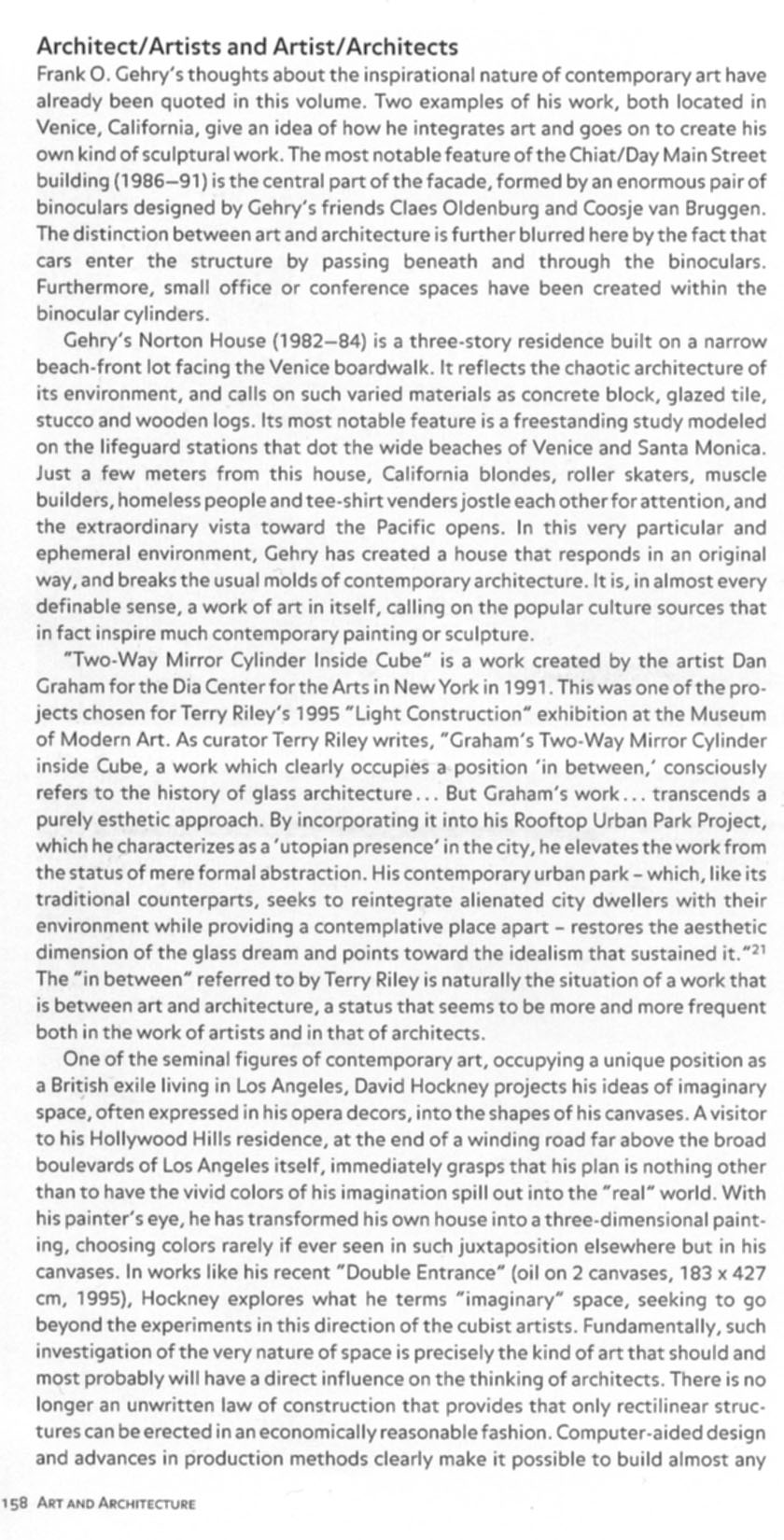78489 New Forms Taschen 148

Architect/Artists and Artist/Architects
Frank O. Gehry's thoughts about the inspirational naturę of contemporary art have already been quoted in this volume. Two examples of his work, both located in Venice, California, give an idea of how he integrates art and goes on to create his own kind of sculpturai work. The most notable feature of the Chiat/Day Main Street building (1986-91) is the central part of the facade. formed by an enormous pairof binoculars designed by Gehry's friends Claes Oldenburg and Coosje van Bruggen. The distinction between art and architecture is further blurred here by the fact that cars enter the structure by passing beneath and through the binoculars. Furthermore, smali office or conference spaces have been created within the binocularcylinders.
Gehry's Norton House (1982-84) is a three-story residence built on a narrow beach-front lot facing the Venice boardwalk. It reflects the chaotic architecture of its environment, and calls on such varied materials as concrete błock, glazed tile, stucco and wooden logs. Its most notable feature is a freestanding study modeled on the lifeguard stations that dot the wide beaches of Venice and Santa Monica. Just a few meters from this house, California blondes, roller skaters, muscle builders, homeless people and tee-shirt venders jostle each other for attention, and the extraordinary vista toward the Pacific opens. In this very particular and ephemeral environment, Gehry has created a house that responds in an original way, and breaks the usual molds of contemporary architecture. It is, in almost every definable sense, a work of art in itself, calling on the popular culture sources that in fact inspire much contemporary painting or sculpture.
"Two-Way Mirror Cylinder Inside Cube" is a work created by the artist Dan Graham for the Dia Center for the Arts in New York in 1991. This was one of the pro-jects chosen forTerry Riley's 1995 "Light Construction" exhibition at the Museum of Modern Art. As curator Terry Riley writes, "GrahanYs Two-Way Mirror Cylinder inside Cube, a work which clearly occupies a position 'in between/ consciously refers to the history of glass architecture... But GrahanYs work... transcends a purely esthetic approach. By incorporating it into his Rooftop Urban Park Project, which he characterizes as a 'utopian presence' in the city, he elevates the work from the status of mere formal abstraction. His contemporary urban park - which, like its traditional counterparts, seeks to reintegrate alienated city dwellers with their environment while providing a contemplative place apart - restores the aesthetic dimension of the glass dream and points toward the idealism that sustained it."J1 The "in between" referred to by Terry Riley is naturally the situation of a work that is between art and architecture, a status that seems to be morę and morę frequent both in the work of artists and in that of architects.
One of the seminal figures of contemporary art, occupying a unique position as a British exile living in Los Angeles, David Hockney projects his ideas of imaginary space, often expressed in his opera decors, into the shapes of his canvases. A visitor to his Hollywood Hills residence, at the end of a winding road far above the broad boulevards of Los Angeles itself, immediately grasps that his plan is nothing other than to have the vivid colors of his imagination spili out into the "real" world. With his painter's eye, he has transformed his own house into a three-dimensional painting, choosing colors rarely if ever seen in such juxtaposition elsewhere but in his canvases. In works like his recent "Double Entrance" (oil on 2 canvases, 183 x 427 cm, 1995), Hockney explores what he terms "imaginary" space, seeking to go beyond the experiments in this direction of the cubist artists. Fundamentally, such investigation of the very naturę of space is precisely the kind of art that should and most probably will have a direct influence on the thinking of architects. There is no longer an unwritten law of construction that provides that only rectilinear struc-tures can be erected in an economically reasonable fashion. Computer-aided design and advances in production methods clearly make it possible to build almost any
158 Art ano Architecture
Wyszukiwarka
Podobne podstrony:
New Forms Taschen 119 ern artists to touch fundamenta! elements that are still very much part of eve
New Forms Taschen 123 Cultural Centers and Concert Halls The trend toward cultural centers intended
New Forms Taschen 144 architecture: "The installation represents the work site of an enormous b
New Forms Taschen 097 I M . Pei Rock and Roli Hall of Famę Cleveland, Ohio, 1993-95 With its py
19818 New Forms Taschen 097 I M . Pei Rock and Roli Hall of Famę Cleveland, Ohio, 1993-95 With
62302 New Forms Taschen 079 California architect Frank O. Gehry this trend has been a source of some
New Forms Taschen 210 links between and the closeness of art and science. This theoretical input is
więcej podobnych podstron